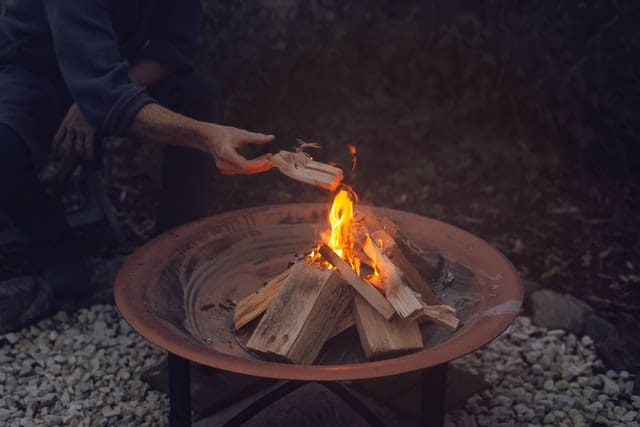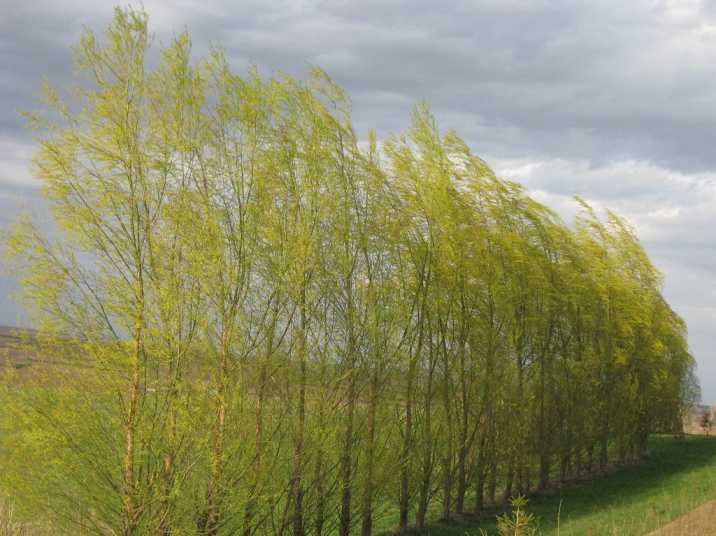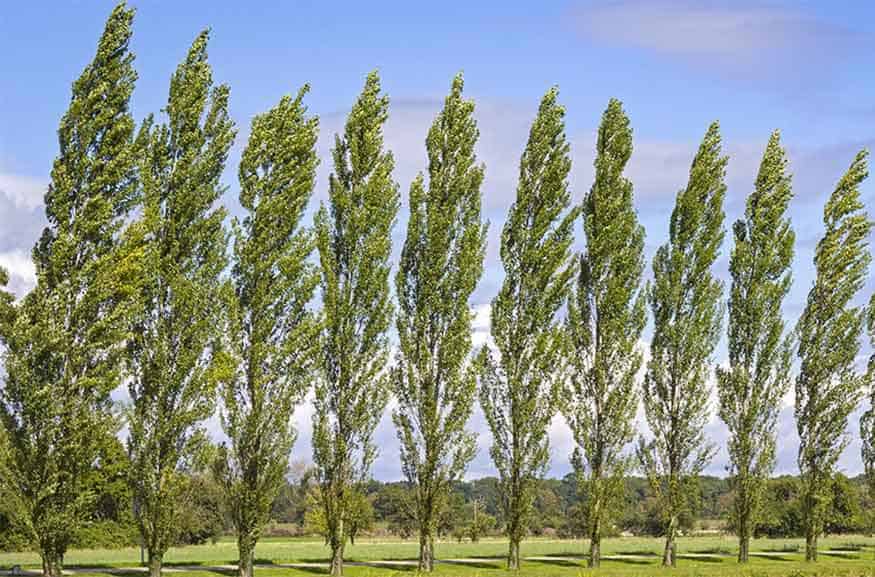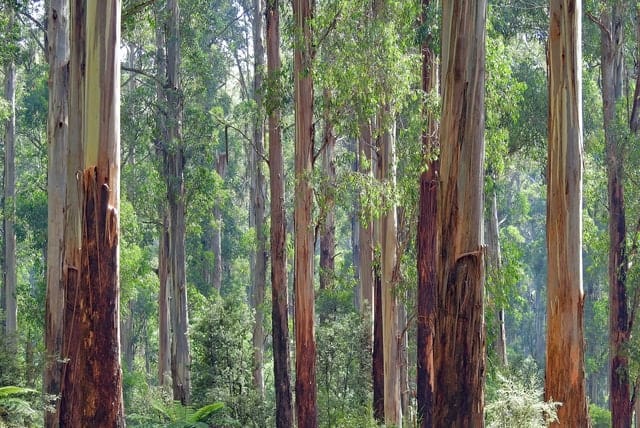This article highlights the fastest species of tress you can grow in the USA based on your own individual planting space and wood requirements. It is important your figure this out for yourself before making a decision.

Table of Contents
Why grow your own firewood?
Growing your own firewood can reduce fuel bills and make yourself independent of fuel companies when you take it to the extreme.
It’s also particularly useful if you want to have the slightly comedic moral high ground of growing your own, sustainably sourced firewood and reducing your carbon footprint.
The amount of firewood you would need is entirely dependent on the frequency and magnitude of the fires you burn. Perhaps you have your own fireplace indoors, or your own fancy log oven.
Is it realistic to grow your own firewood?
If your outdoor space is large enough and you don’t use much wood it is completely reasonable to grow all of the firewood you burn yourself.
However, even with a small log burning fire used once a week throughout the winter you are still looking at least 0.25 – 0.5 acres of land dedicated solely to tree planting.
You will also have to make sure you cut and dry your wood about 2 months in advance of burning your log fire, depending on the species of tree.
What is the fastest growing trees for firewood?
For each of the below trees I have compiled all the data you’d need to make the best decision. You’ll be able to create your very own self-sustaining forest of trees based on the fastest growing species I know of grown in the USA.
Please carefully plan out your requirements below – it makes a big difference!
How much wood do you need per year?
| One fire burning firewood | Wood needed (tonnes) |
|---|---|
| One log fire used for one day a week in the winter | 1 tonne |
| One log fire used in the winter on weekends | 2 tonnes |
| One log fire used in the winter 3-4 days per week | 4 tonnes |
| One log fire used in the winter every day | 8 tonnes |
| One log fire used throughout the year | 24 tonnes |
This table will give you a good estimate of the wood required for your use.
Willow
Willows are grown in a range of varieties. Most would have heard of the weeping willow. However arguable the fastest growing variety would be the Austree Willow hybrid. Metrics and guidance on this tree species has been calculated for willows in general.

How fast does it grow?
Each willow tree can grow 8 – 12 feet per year.
How much wood do willows produce per year?
It is important to note you will not be able to harvest your willow until about three years of un-pruned growth. Once mature, willows should produce 3-5 tonnes of dry wood per acre. One acre of tree farming could easily yield you enough wood for most people’s needs.
Pros
- Willows can double as effective windbreaks on open land
- Handles cold temperatures extremely well. Ideal for climates in the USA with hot summers and cold winters
- Pest resistant
- Extensive root system helps the health of your soil
Cons
- Has a lot of shedding leaves, late in to the year.
- The long tendrils can be hard to manage
Optimal growing conditions
Deep, moist well drained soil that is exposed to full sun is the best conditions for willows to grow to their full potential and maximum yield. Slightly acidic soil is also a bonus.
You can test your soil acidity by using PH monitors like this one. You should also keep your willows pruned to maximize sunlight to other willows surrounding it and plant them 2-3 feet from each other.

Poplar
The tall trees can grow a lot with little vegetation cover. There are again like most trees on this list, hybrids that grow faster than other. Try and find out as much information as you can about the tree variety before buying. The main thing you want to worry about is

How fast does it grow?
The tree can grow up to 7 feet per year in optimal conditions
How much wood do poplar trees produce per year?
Minimum 2.3 tonnes up to 6 tonnes per acre per year. Depending on the maturity of the tree. However you would have to wait up to five years before your trees are mature enough to even produce the minimum tonnage.
Pros
- Tall trees can also provide privacy
- Can be burned green although it will produce a lot of smoke
- Ideal for summer fired as it doesn’t burn for a long time
Cons
- May need to hire a logger to prune poplar as they grow very tall
- The nature of the growth pattern of branches makes them susceptible to breaking off and causing a hazard during high wind
- Need to be planted away from infrastructure due to shallow roots
Optimal growing conditions
Poplar trees aren’t specific with the type of acidity they need for optimal growth as long is the soil is fertile. Because of the height of the tree and their extremely long and narrow growing pattern, poplar trees can be planted as close as 3 to 4 feet apart.
However, due to the root structure of poplars it is recommended to also plant them 20 feet away from sidewalks, patios and houses to prevent complications in years to come.
Non-native Eucalyptus
The non native eucalyptus is a tree with Australian roots that made its way to the USA in the 1900s. That is why is called non native. In recent years, in some states it is deemed an invasive species as it is able to be a fire hazard, and change the soil chemistry of the local area. However, when planted correctly, the non-native eucalyptus tree is a great choice for firewood.
Cut it down every year before it grows to heights you cannot manage for easy firewood.

How fast does it grow?
Some species are known to grow up to 16 feet per year and some just 2 to 3 feet per year. Of course, you would want the fastest growing for your outdoor space so depending on what type of tree you can get your hands on where you live. Here are some of the fastest growing variants that I would recommend seeking out.
How much wood per year?
Eucalyptus trees will produce on average 5 – 6 tonnes of wood per year per acre for the fastest growing variants in the optimal conditions. It also contains oils and extracts that make the wood burn with a higher than normal temperature and a longer burn time. Hence the tree also being a fire hazard.
Pros
- Resistant to forms of decay due to the oil extracts It contains
- Contains oils that allow firewood to burn for longer and hotter
- Easily grown from seeds. No cutting necessary
Cons
- Can only be grown in hot climates
- Produces a natural fire hazard so must be planted away from infrastructure
- Has the potential to ruin soil PH levels for future planting
Optimal growing conditions
First of all it is important to note that the optimal growing conditions for eucalyptus trees are where the weather is above 50°F year round and on average 65°F to 71°F. You can still grow the plant if you weather isn’t that hot but expect slower growth. You should plant the trees in well-drained soil 1 – 2 feet apart.
Alternatives to growing your own firewood
Look I get it… part of the appeal to growing your own firewood is creating that sense of, instinct driven, living off the land, off grid feeling you get with growing your own.
However, when it comes to firewood, it is arguably one of the bigger gardening tasks you’ll ever set about on. It is completely reasonable to think again and re-plan. Especially when you consider the time investment in a project like this.
While you wait for your trees to grow or you may decide to not plant your own firewood at all, here are some alternatives:
- Organic Briquettes
- Buy your firewood in bulk once a year
- Lava rocks
- Gas fire
Pro tip:
In order to speed up the process of growing your own trees. Find someone with their own tree farm and take cuttings with their permission. This will allow you to save yourself from planting from seed and maybe save yourself a few years of waiting to harvest your firewood.
This works in a similar way to repairing broken plant stems except you’d be repotting the stem to grow yourself
